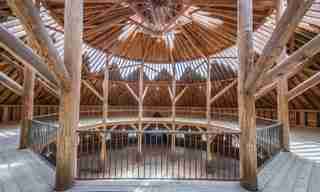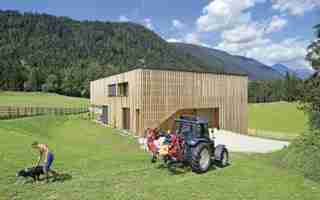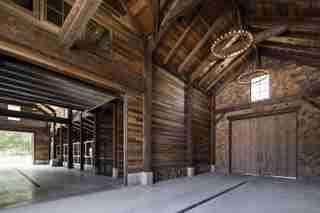Some of the world’s most functional architecture can be found on the farm. From farmhouses to stables to barns, farming structures value simplicity and practicality above all. The efficiency of these buildings has long been an inspiration to modern architects designing homes, museums, and commercial buildings, but lately modern architecture has also been influencing farms. In the upcoming book The New Farm: Contemporary Rural Architecture (Princeton Architectural Press, $45), author Daniel P. Gregory explores how firms have taken a bolder approach to agricultural design with striking exteriors, grand interiors, and inventive materials. Gregory showcases 16 farms around the world, from a cathedral-like dairy farm in New York state to sleek stables in New South Wales, Australia. Each of the family businesses offers a new take on farming traditions with an eye to sustainability and beautiful design. Read on to visit nine of the farms featured in the book.

Churchtown Dairy (Hudson, New York)
Builder Rick Anderson designed a four-story round barn for Churchtown Dairy, a biodynamic farm founded by Abby Rockefeller. The domed structure houses cows during the winter and serves as an event space in the summer when they have returned to the pasture. The complex includes several buildings that Anderson reassembled on the property, including a cheese cave and an 1850s milking barn from New Hampshire.

Prugger Farm (Rasen-Antholz, South Tyrol, Italy)
On a 21-acre farm in the Dolomites, architect Reinhard Madritsch created a structure that could serve as a home for the Prugger family and a barn for their Scottish Highland cattle. The cubic building is wrapped in vertical strips of wood and set into a hillside, creating separate levels for living and working.

Snuck Farm (Pleasant Grove, Utah)
Owner Page Westover turned to architectural designer Louise Hill and architect Warren Lloyd to devise a barn that felt as if it had been there for decades. One side of the structure has a commercial kitchen and lofted space for an office, while the other is reserved for the animals, including alpacas and chickens. The timber-framed building uses reclaimed wood (for sustainability), locally quarried stone, and board-formed concrete for a rustic feel.
Mason Lane Farm (Goshen, Kentucky)
Louisville architects Roberto De Leon and Ross Primmer chose an unconventional material and design for a hay storage barn at Mason Lane Farm. Kentucky cane, a type of bamboo, was sourced from a nearby nursery and used to create an eye-catching lattice motif that also allows air to circulate. The building was inspired by old tobacco barns and sits beside a corrugated metal-sided main barn, which was designed to complement the geometry of the bamboo.
Schönenberg Farm (Basel, Switzerland)
Architect Georg Schmid’s firm F.A.B. (Forschungs- und Architekturbüro) collaborated with professional barn builders and took inspiration from the natural surroundings when designing a cow barn for the Schmid family’s farm outside of Basel. The new building blends into the sloping landscape thanks to the eco-friendly green roof, planted with the same grass that appears in the farm’s meadows, and the screens of woven hazel tree trunks—also indigenous to the property—that line the exterior.
Oosterhout Farm (Rijswijk, The Netherlands)
Ivar van der Zwan, of Workshop Architecten, was influenced by old black Dutch barns when designing a barn for the 12.8-acre farm of Marc Oosterhout, founder Dutch advertising firm N=5, and his wife, Margot. The stained Douglas fir–clad structure is topped with solar panels to help achieve the family’s goal of living off the grid and includes a sheep pen and hayloft, a central atrium that can serve as a winter garden and workspace, and a two-story apartment.
Crackenback Stables (Thredbo, New South Wales, Australia)
Rob Brown of Casey Brown Architecture reinvented the traditional shed with his design for Crackenback Stables in Australia’s Snowy Mountains. He used corrugated iron and panels of rusted steel for the exterior of the structures, which includes two pavilions housing a horse barn, living quarters, and equipment storage.
Waterview (North Bruny Island, Tasmania, Australia)
At Waterview, architect John Wardle’s 1,087-acre sheep ranch, a shearer’s quarters was constructed to house guests as well as shearers who stay onsite during the annual wool harvest. The building was designed to contour to the sloping site and opens up to expansive views of the coast and the fields where the 1,500–2,000 sheep graze.
Swallowfield Farm (Langley, British Columbia)
The two-story barn at Swallowfield Farm graces the cover of The New Farm . Designed by architect Asher deGroot, the son of owners Jenny and Dennis deGroot, the barn features a distinctive “off-kilter” roof line, and the second floor includes a hayloft and gathering space illuminated by a skylight.
